Homemade Cornbread Croutons: Elevate Your Salads and Soups with Crispy, Buttery Goodness
Crispy, crunchy, sweet, and wonderfully buttery, these homemade Cornbread Croutons are a delightful upgrade that takes your everyday salads and soups from good to gourmet. This versatile recipe allows you to either create fresh cornbread from scratch using our simple guide below or ingeniously transform any leftover cornbread into these golden, irresistible nuggets. We also include optional variations for those seeking dairy-free and gluten-free options, ensuring everyone can enjoy this fantastic addition to their meals!
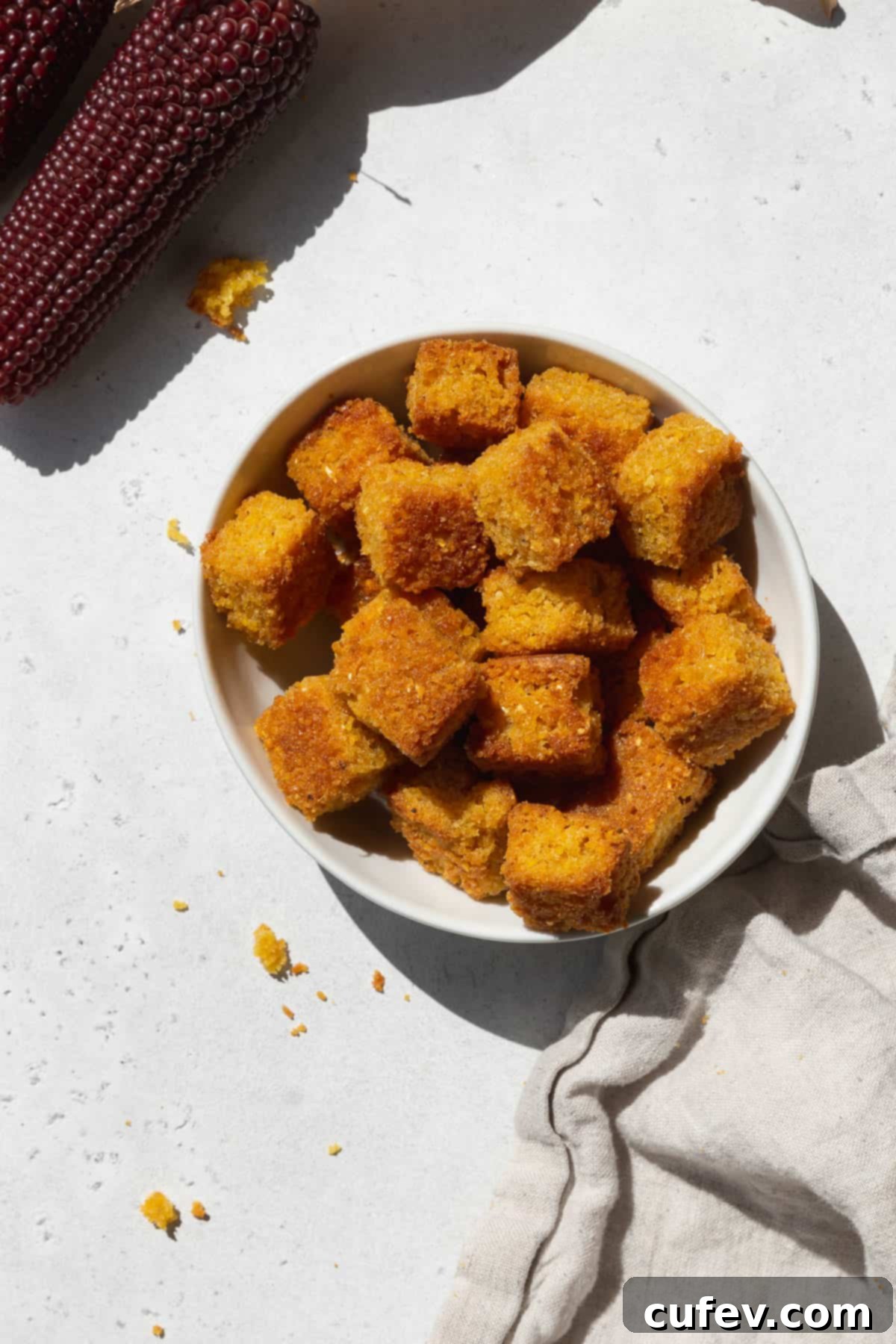
Cornbread croutons represent the perfect marriage of two beloved culinary classics: the comforting, rich flavor of cornbread and the satisfying crunch of traditional croutons. With a wonderfully crunchy exterior that gives way to a buttery, tender interior, these golden nuggets are more than just a topping; they’re a transformative element that enhances almost any salad, soup, or even a simple snack.
Imagine sprinkling these savory, slightly sweet croutons on a vibrant fall salad, perhaps an arugula pear salad or a hearty autumn kale salad. Their unique texture and flavor profile provide a delightful contrast that elevates the entire dish. They’re equally spectacular when scattered generously over a steaming bowl of creamy tomato soup or a rich, comforting pumpkin soup, adding a gourmet touch that store-bought croutons simply can’t match. And let’s be honest, sometimes these crispy cornbread bites are so good, you’ll find yourself snacking on them straight from the baking sheet!
This recipe provides a complete guide, starting with our easy-to-follow homemade cornbread recipe. However, if you’re looking for a quick and clever way to use up existing leftovers, this recipe is your ideal solution. For the absolute best results and the crispiest texture, we highly recommend using day-old cornbread if you’re making it fresh. The slightly drier texture of leftover bread absorbs the olive oil more effectively, leading to that coveted, irresistible crunch.
Why You’ll Adore These Cornbread Croutons
- Unforgettably Crispy and Crunchy. While cornbread is already delicious on its own, baking it into croutons transforms its texture. The baking process creates an incredibly golden-brown, crispy exterior that offers an incredibly satisfying crunch with every bite, far superior to soft bread cubes. This irresistible texture adds an exciting dimension to any dish.
- Rich and Buttery Flavor Profile. Even without adding extra butter directly into the crouton mixture (though you certainly could!), the homemade cornbread base brings a profound richness. The buttermilk, oil, and eggs in the cornbread itself infuse each crouton with savory and decadent flavors, creating a depth that belies the simplicity of the preparation. This unique flavor sets them apart from standard croutons.
- Remarkably Versatile. These crispy golden nuggets are incredibly adaptable. You can enjoy them anywhere you would typically use classic croutons, and often, they’ll be a more exciting choice. Use them to top fresh green salads, hearty grain bowls, creamy tomato or vegetable soups, chili, stews, or even as a standalone savory snack. They’re rarely unwelcome and always impress!
- A Fantastic Way to Utilize Leftover Cornbread. If you frequently find yourself with extra cornbread after a meal, this recipe is a brilliant and delicious solution. Instead of letting day-old cornbread go to waste, you can easily repurpose it into these gourmet croutons, whether your cornbread is store-bought or a cherished family recipe. It’s a simple act of culinary magic that prevents food waste and rewards you with something truly special.
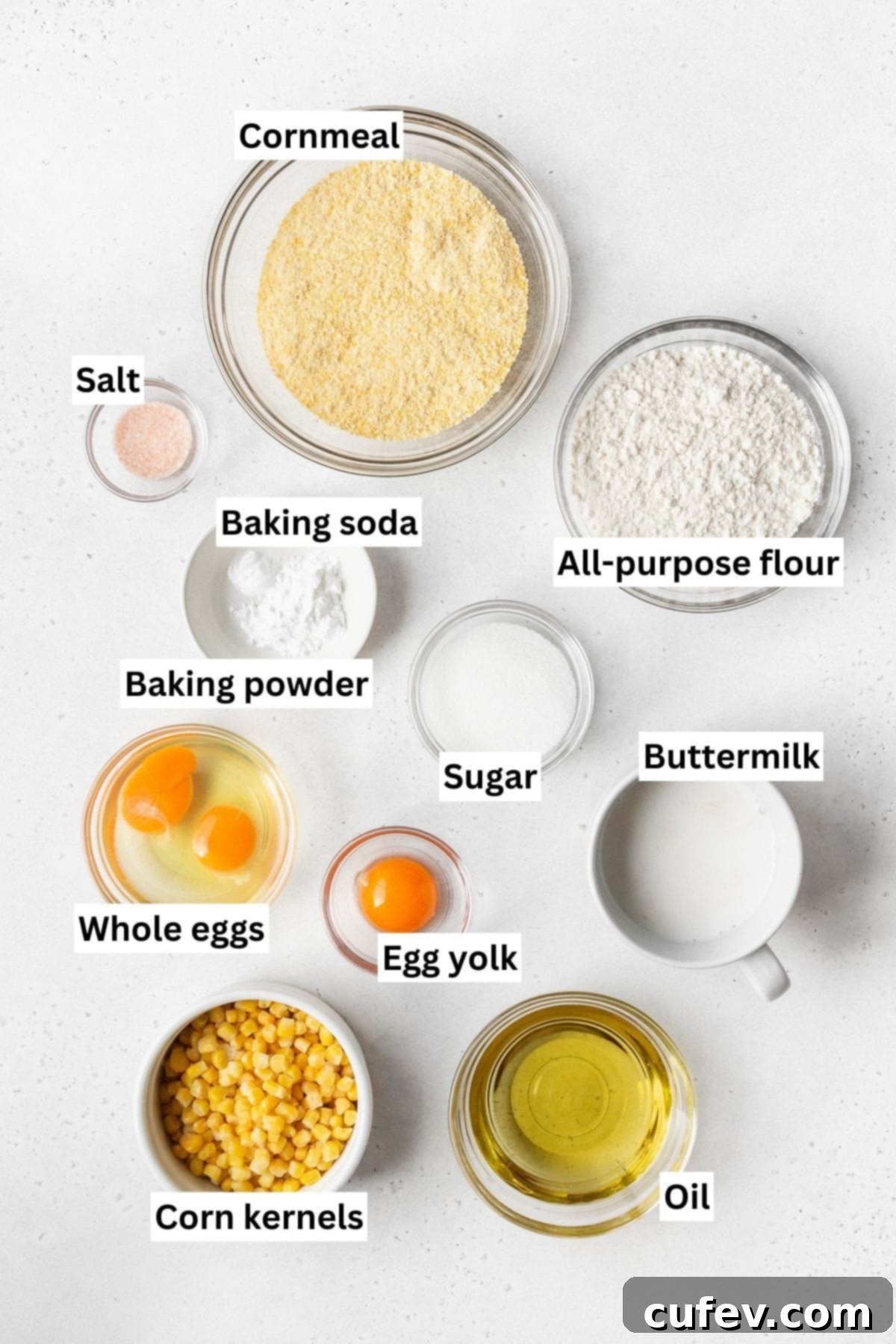
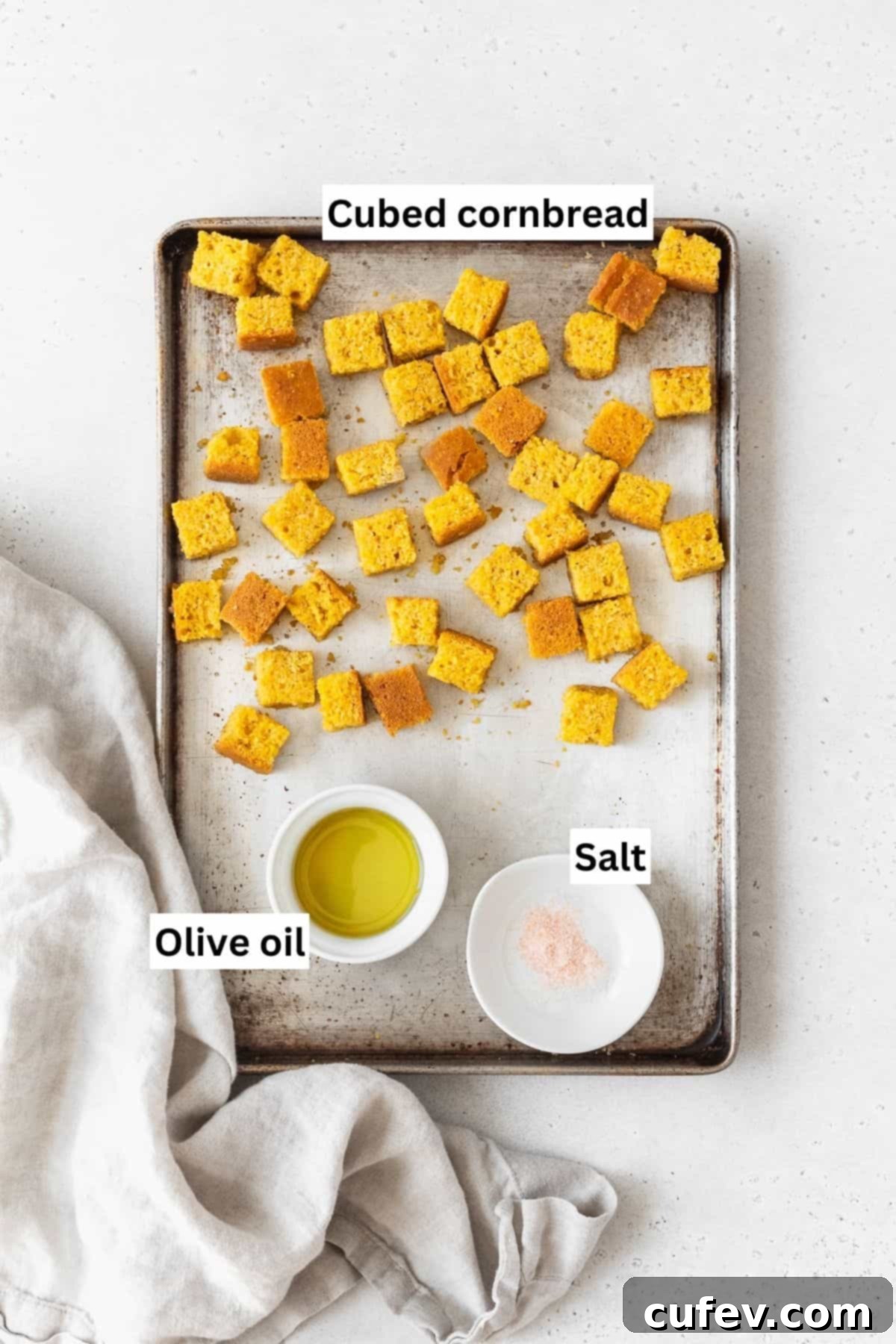
Essential Ingredients for Cornbread Croutons
This fantastic homemade cornbread croutons recipe relies on a straightforward list of common pantry staples, making it incredibly accessible. If you already have some delicious leftover cornbread on hand, you’ll only need two additional ingredients to transform it into these crunchy delights!
For the Homemade Cornbread Base
- All-Purpose Flour – This provides the necessary structure and body for your cornbread. For a lighter, more wholesome bread, opt for unbleached flour whenever possible.
- Cornmeal – The heart of your cornbread! Choose a fine or medium-ground yellow cornmeal for the best texture and classic cornbread crumb. The grind size significantly impacts the final feel of your croutons.
- Corn Kernels– Adding fresh, canned (drained), or frozen (defrosted) corn kernels enhances the corn flavor and adds bursts of sweetness and a pleasant textural element to the bread.
- Buttermilk – Crucial for a tender and moist crumb, buttermilk reacts with the leavening agents to give the bread its rise. If you don’t have store-bought buttermilk, you can easily make your own “sour milk” at home (see our “Recipe Success Tips” below for instructions).
- Eggs & Egg Yolk – Eggs act as a binder, helping to hold the cornbread together, while also contributing to its rich, savory flavor and moist texture. The extra yolk adds richness and tenderness.
- Oil – A neutral-flavored oil like avocado oil or light olive oil works perfectly here, contributing moisture without overpowering the corn flavor. For an “olive oil cornbread” with a more pronounced savory note, you can use extra virgin olive oil.
- Sugar – A modest ¼ cup of granulated sugar balances the savory notes of the corn, adding a touch of sweetness without making the cornbread overly dessert-like. This balance is key for versatile croutons.
- Baking Soda & Baking Powder – These leavening agents work in harmony to give the cornbread its perfect rise and tender, airy crumb. Ensure they are fresh for optimal results.
- Salt – An essential flavor enhancer, salt not only accentuates the inherent sweetness of the corn but also brings out all the other delicious flavors in your cornbread, creating a well-rounded taste.
For the Crispy Cornbread Croutons
- Olive Oil – This flavorful and healthy fat is key to achieving that desired crispness. It coats each cornbread cube, transforming them into crunchy, golden bites that are utterly delicious. Its subtle fruity notes complement the cornbread beautifully.
- Salt – A sprinkle of sea salt or Himalayan pink salt will provide the best, most nuanced flavor, enhancing the savory profile of the croutons. Standard table salt can also be used effectively.
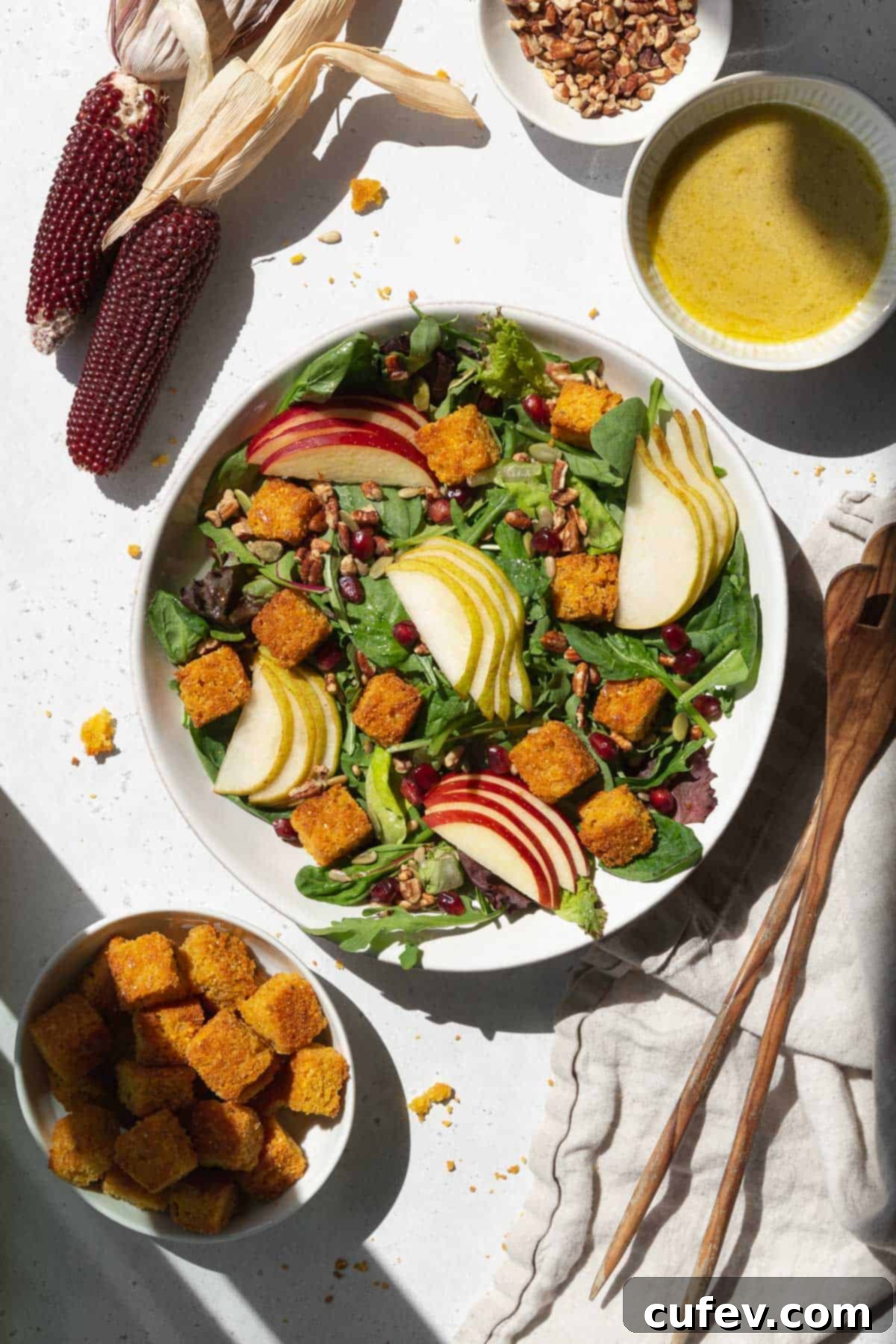
Crafting Your Cornbread Croutons: A Step-by-Step Guide
Creating homemade cornbread croutons is surprisingly simple and yields a magnificent payoff in both flavor and texture. Whether you’re a seasoned baker or a kitchen novice, you’ll find these steps easy to follow. If you’re already starting with leftover or pre-made cornbread, feel free to skip directly to the “Baking Cornbread Croutons” section for a quicker route to crunchy perfection.
Part 1: Preparing Your Homemade Cornbread Base
Step 1: Begin by preheating your oven to 400°F (200°C). This ensures the oven is at the correct temperature for even baking. Lightly grease an 8 x 8-inch square baking pan with a neutral oil, ensuring all surfaces are covered to prevent sticking, then set it aside.
Step 2: In a spacious mixing bowl, combine all your dry ingredients: the all-purpose flour, cornmeal, salt, baking soda, and baking powder. Whisk these together thoroughly to ensure they are well-incorporated and evenly distributed. This step is crucial for consistent rise and texture in your cornbread.
Step 3: For an extra burst of corn flavor and a smoother texture in your cornbread, add the buttermilk and corn kernels to a blender. Purée the mixture until it’s completely smooth. This creates a beautifully integrated corn flavor throughout your bread. If you prefer a more rustic texture, you can omit this step and add the corn kernels directly to the wet ingredients later.
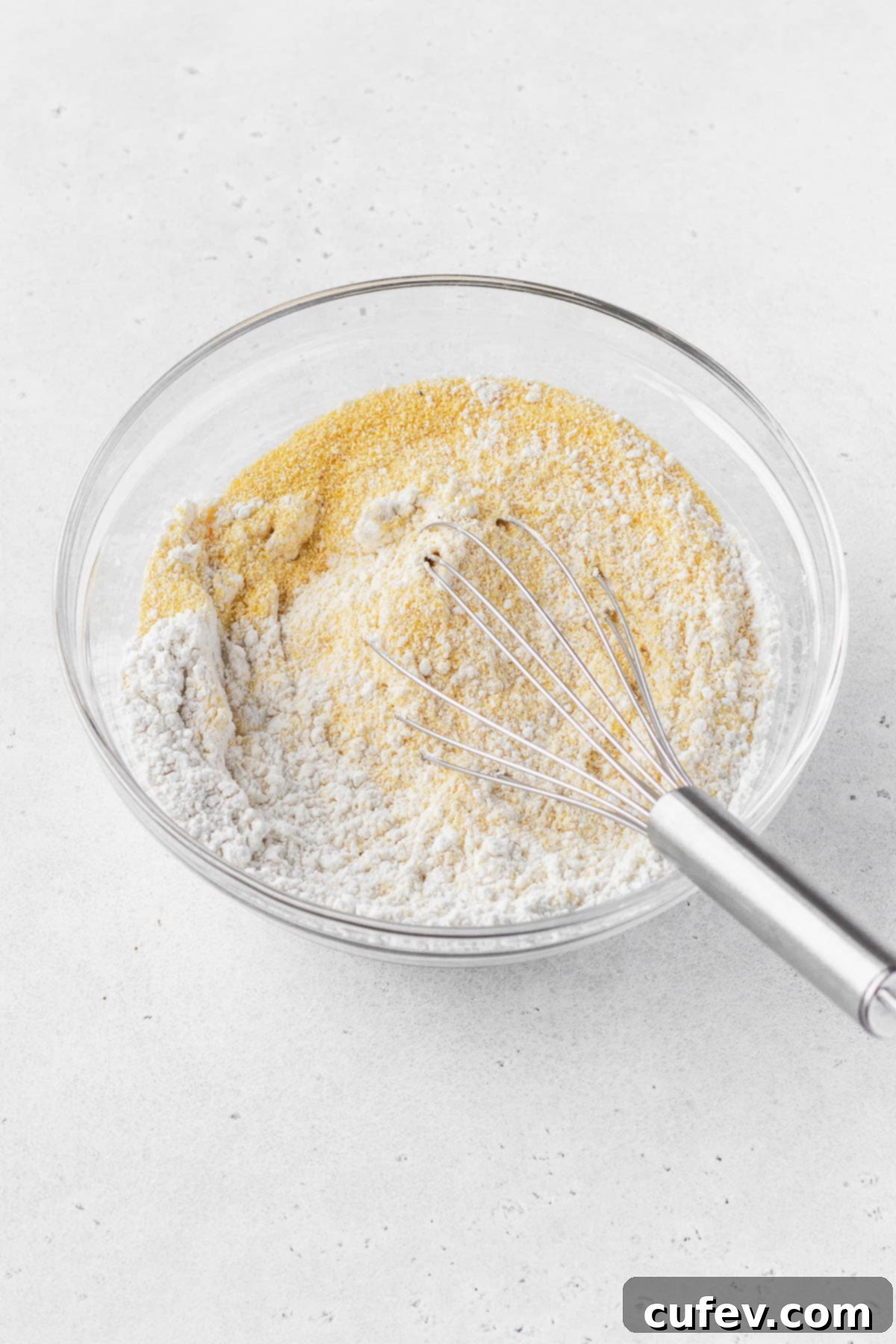

Step 4: Pour the puréed buttermilk and corn mixture into another large mixing bowl. Add the granulated sugar, oil, two large eggs, and the extra egg yolk. Stir these wet ingredients gently until they are just combined, ensuring a consistent mixture without overbeating.
Step 5: Gradually add the whisked dry cornmeal mixture into the wet ingredients. Stir only until the ingredients are just moistened and smooth. Be careful not to overmix; overmixing can develop the gluten in the flour too much, resulting in a tough, dense cornbread rather than a tender, crumbly one.
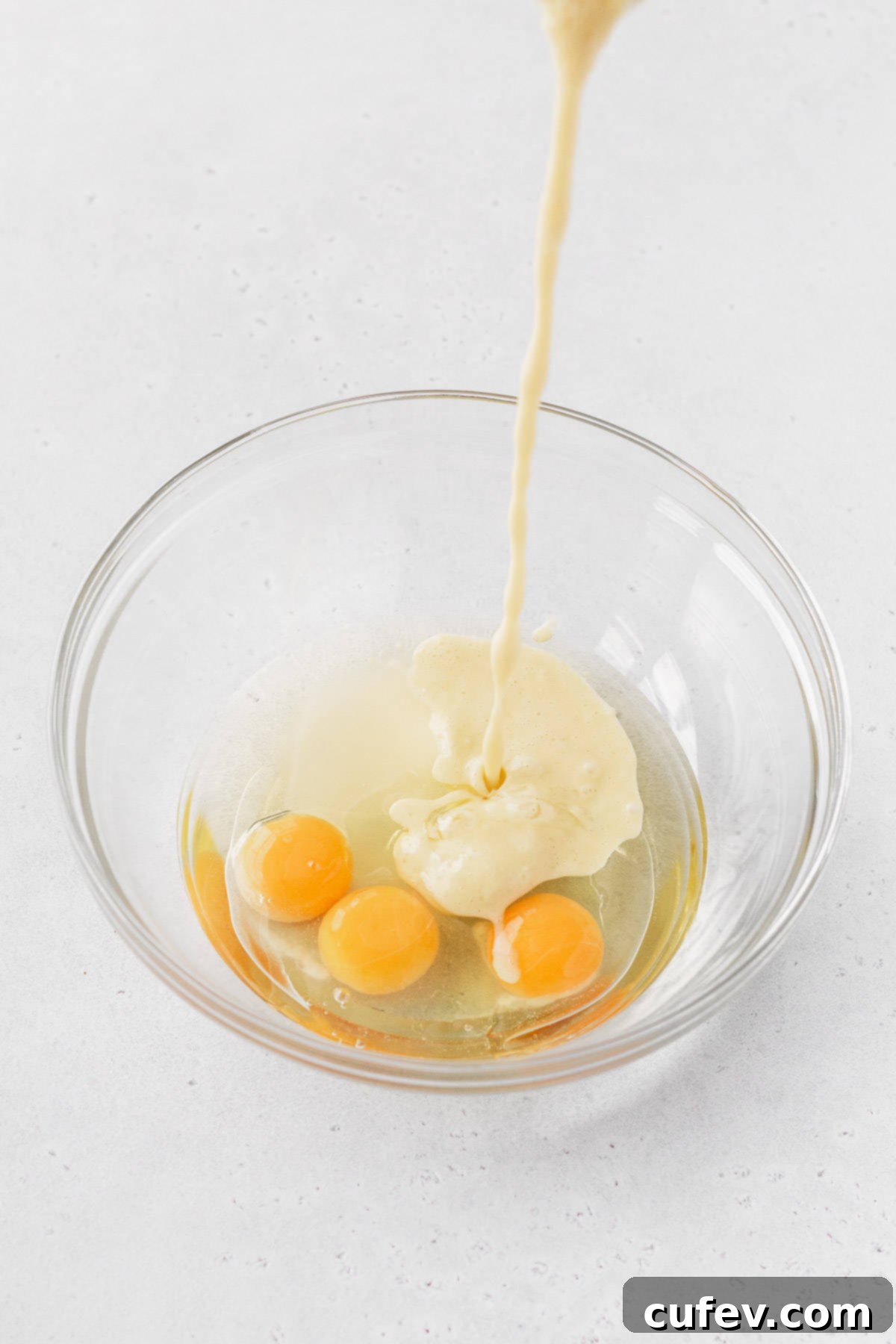
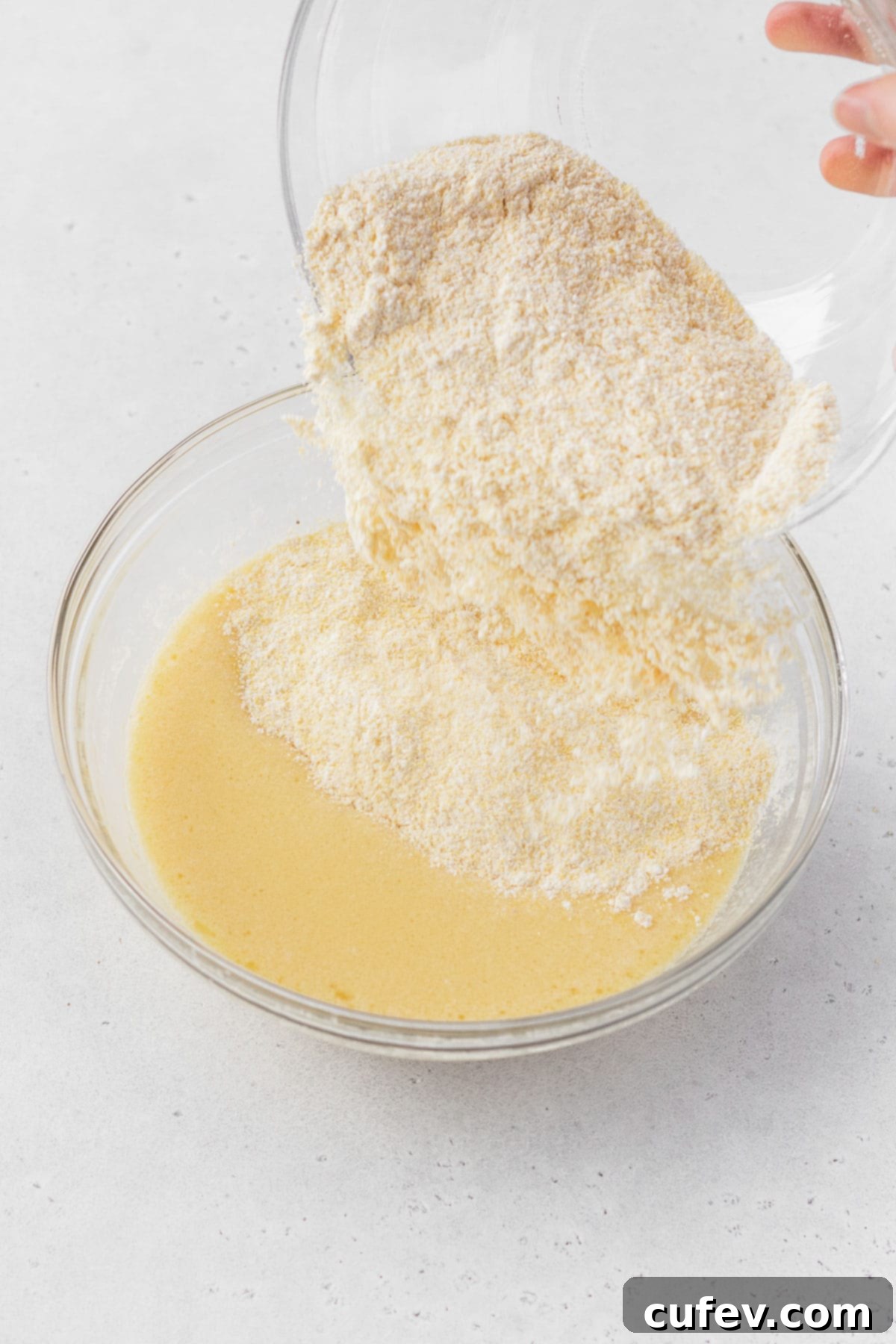
Step 6: Carefully pour the prepared cornbread batter into the greased 8×8-inch pan. Use a spatula to spread the mixture evenly and smooth out the top, ensuring uniform thickness for even baking.
Step 7: Bake the cornbread in the preheated oven for 40-45 minutes. You’ll know it’s done when a toothpick inserted into the center comes out with only a few moist crumbs attached, indicating it’s cooked through but still tender. Once baked, remove the pan from the oven and allow the cornbread to cool completely on a wire rack before attempting to cut it. This cooling process is essential for preventing crumbling and achieving clean cuts, especially for croutons.
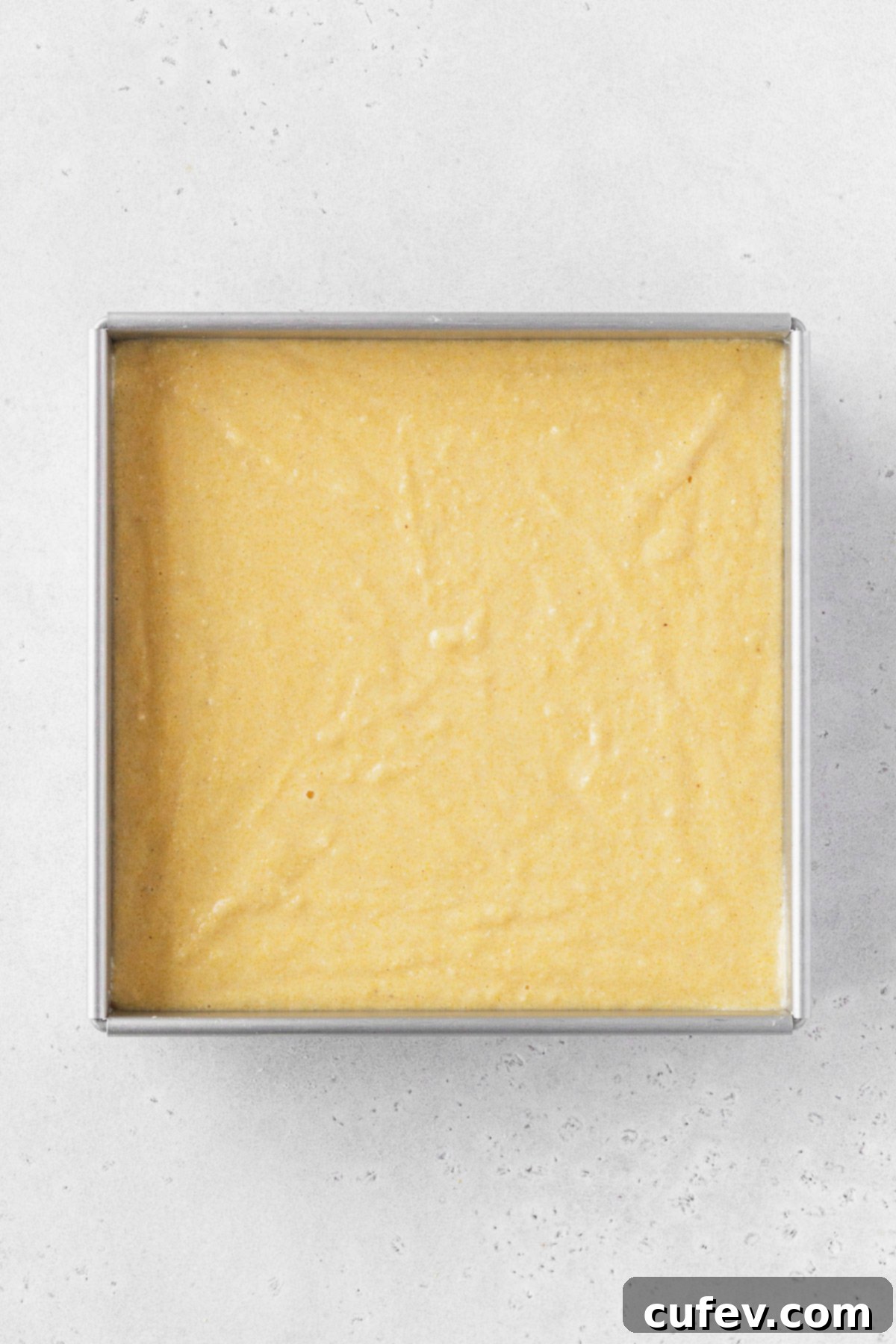

Part 2: Transforming into Crispy Cornbread Croutons
Step 1: Once your cornbread is completely cooled (ideally day-old for best results), preheat your oven to 375°F (190°C). This slightly lower temperature ensures even toasting without burning.
Step 2: Carefully cut the cooled cornbread into uniform 1-inch cubes. Uniformity in size is important for even baking and crispness. The cooler and slightly stale the cornbread, the easier it will be to cut without crumbling.
Step 3: Place the cubed cornbread into a large mixing bowl. Drizzle half of the olive oil over the cubes, then sprinkle half of the salt. Gently toss the cornbread cubes to coat them. Repeat this process with the remaining olive oil and salt, tossing again gently until all the cubes are evenly coated. This two-stage coating ensures maximum coverage without overworking the delicate cornbread.
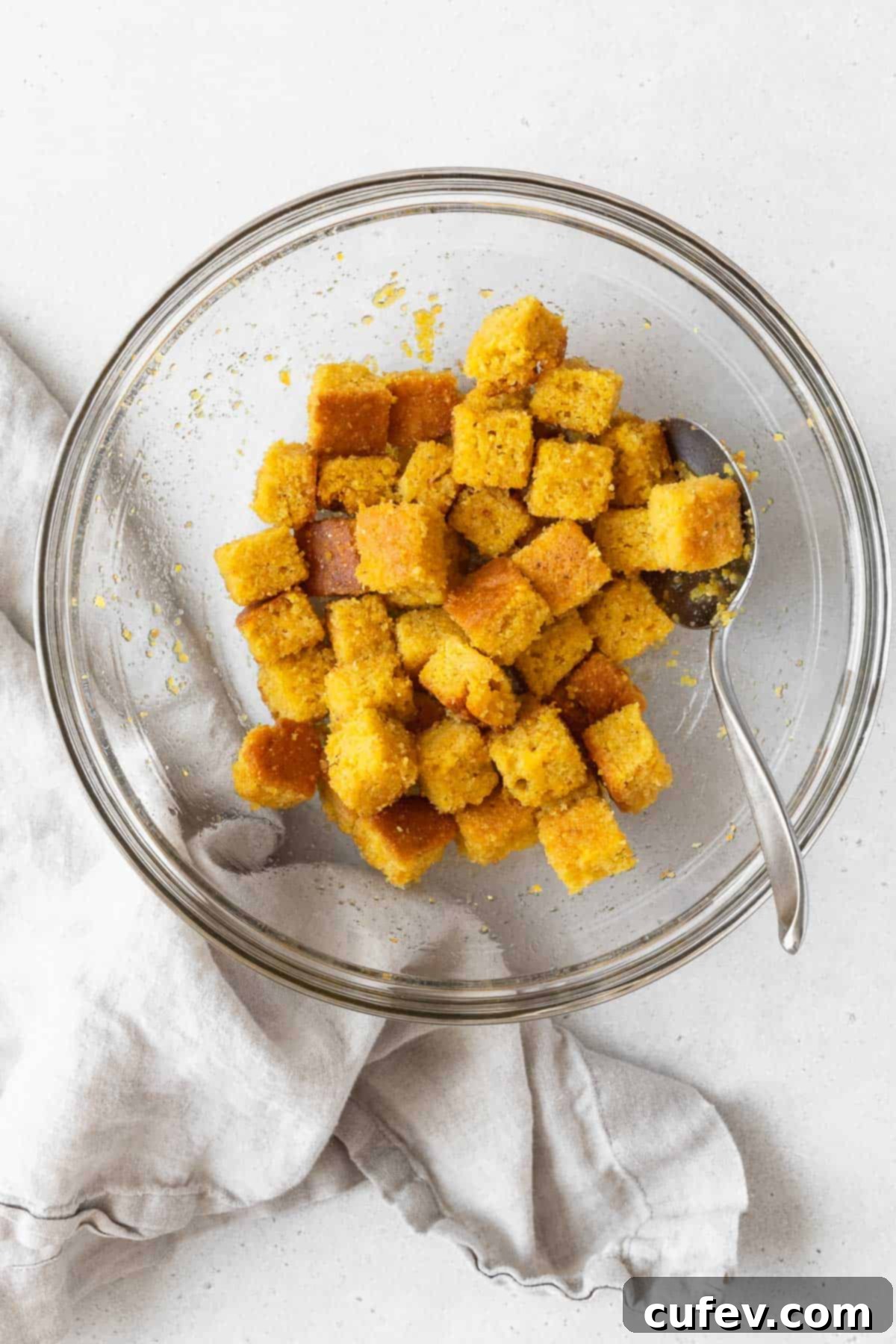
Step 4: Arrange the coated cornbread cubes in a single layer on a large baking sheet. Crucially, ensure there’s at least 1 inch of space between each cube. Overcrowding the baking sheet will trap steam, preventing the croutons from becoming truly crispy and instead making them soft. Use multiple baking sheets if necessary.
Step 5: Bake the cornbread croutons for 15-20 minutes. Halfway through the baking time (around 8-10 minutes), gently toss the croutons to ensure even browning and crisping on all sides. Continue baking until they are golden brown and feel firm to the touch.
Step 6: Once baked to perfection, remove the croutons from the oven. Immediately transfer them to a wire cooling rack and allow them to cool completely. This cooling step on a rack is vital, as the croutons will continue to crisp up and harden as they come to room temperature, achieving that ultimate crunchy texture we’re after.
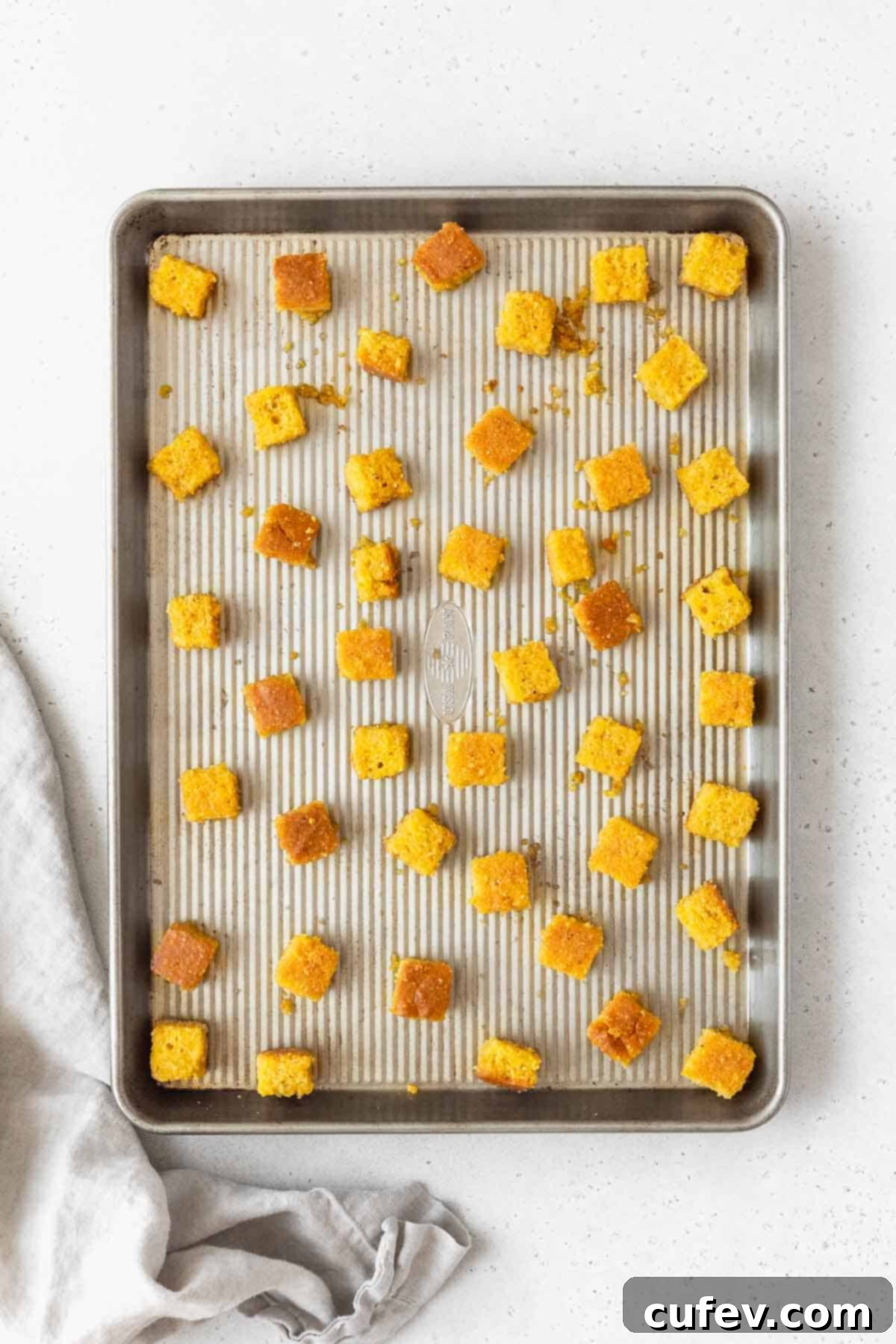

Pro Tips for Perfect Cornbread Croutons Every Time
- Completely Cool Your Cornbread. This is perhaps the most critical step for perfectly formed croutons. Allowing the cornbread to cool fully, ideally for several hours or even overnight, makes it much firmer and less prone to crumbling when you cut it into cubes. Cooler bread also absorbs the oil more evenly.
- Embrace Day-Old Cornbread. While fresh cornbread can work, using bread that’s a day or two old is a game-changer. Its slightly drier, firmer texture is ideal for making the crispiest croutons because it can absorb the oil more efficiently and toast more thoroughly without becoming oily or mushy.
- Gentle Hand is Key When Tossing. Cornbread, even when cooled, can be delicate. When adding the olive oil and salt, use a very gentle hand. Instead of vigorous stirring, carefully turn and fold the cubes with a spatula or your hands until they are uniformly coated. This minimizes breakage and ensures your croutons maintain their shape.
- Avoid Overcrowding the Baking Sheets. For optimal crispness, air circulation is vital. Spread your cornbread cubes in a single layer on the baking sheets, leaving at least 1 inch of space between each piece. If your batch is large, use multiple baking sheets to prevent steam from forming, which would make the croutons soft rather than crispy.
- Optional: Customize Your Seasoning. Feel free to get creative with your crouton seasoning! Beyond salt, you can add a pinch of garlic powder, onion powder, smoked paprika, dried herbs like thyme or rosemary, or even a dash of cayenne for a spicy kick. Add these along with the salt and oil before baking.
- Easy Homemade Buttermilk. Don’t have buttermilk on hand? No problem! It’s incredibly simple to make your own. Just add 1 tablespoon of distilled white vinegar or apple cider vinegar to a 1-cup liquid measuring cup. Then, fill the rest of the cup with your preferred milk (dairy or plant-based). Stir it well and let it sit for 3-5 minutes. The milk will slightly curdle, and it’s then ready to use as a buttermilk substitute in your cornbread recipe.
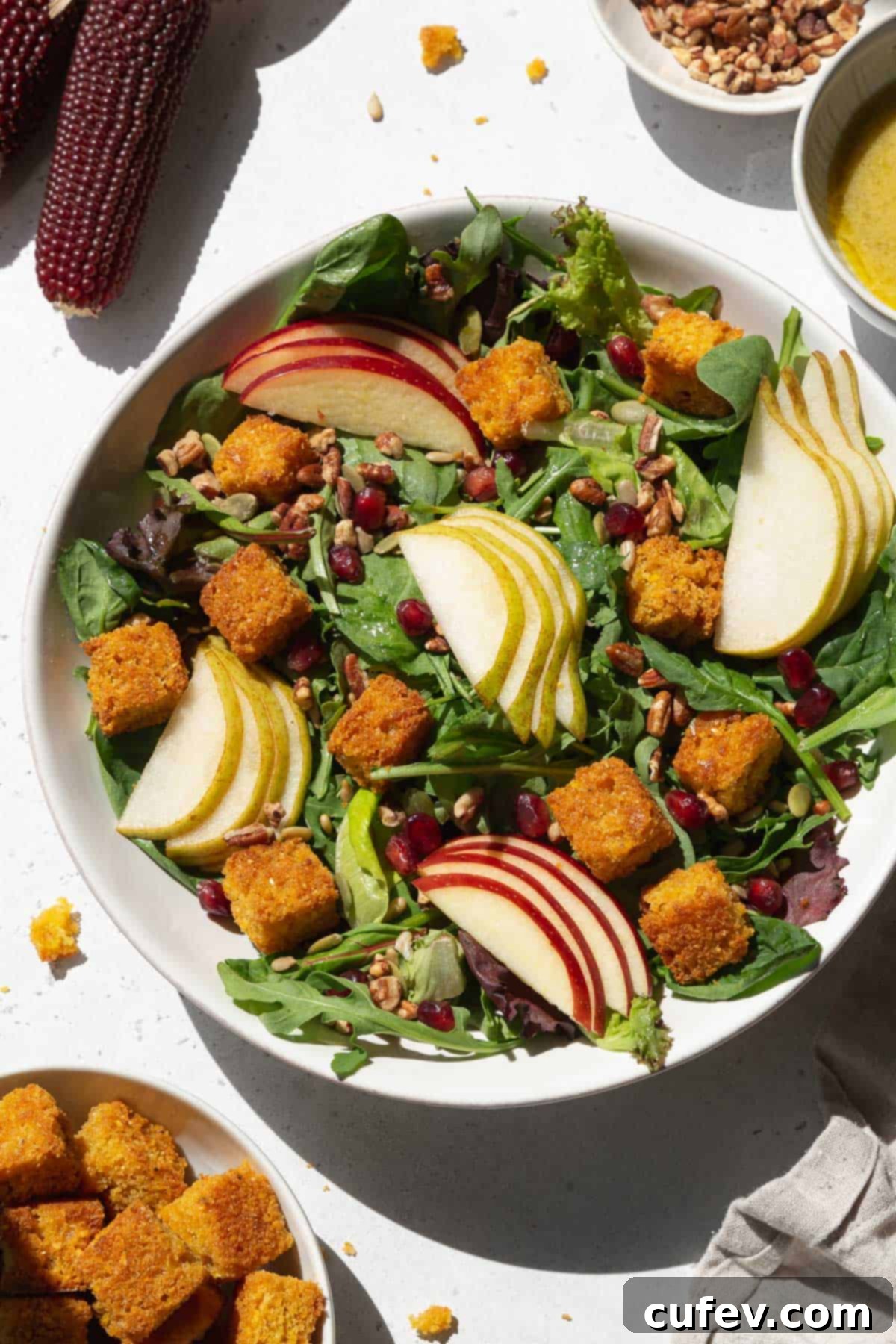
Storage and Reheating Guidelines
- Storage: For peak crispness and flavor, these cornbread croutons are best enjoyed fresh, straight from the oven (after cooling, of course!). However, if you have any delicious leftovers, they can be stored in an airtight container at room temperature for 2-3 days. Make sure they are completely cool before storing to prevent condensation which can lead to sogginess.
- Reheat/Re-crisp: Croutons naturally soften slightly during storage. To bring them back to their glorious crisp state, spread them in a single layer on a baking sheet and re-crisp them in an oven preheated to 350°F (175°C) for 9-11 minutes, or until they are crunchy and heated through. Keep a close eye on them to prevent burning.
Dietary Adaptations for Every Diet
We believe everyone should be able to enjoy these incredible cornbread croutons, regardless of dietary restrictions. This recipe is naturally vegetarian and can easily be made nut-free by using dairy milk or another nut-free plant milk like oat milk or soy milk. Furthermore, it’s remarkably simple to adapt this recipe to be both gluten-free and dairy-free, ensuring deliciousness for all your friends and family.
Making Them Gluten-Free
- To create delightful gluten-free cornbread croutons, simply substitute the all-purpose flour with 1 cup (or 185g) of a good quality 1-to-1 gluten-free baking flour blend. It’s important to choose a blend specifically designed for a 1:1 substitution, as these often contain xanthan gum or other binders to mimic the elasticity of gluten. Follow the rest of the cornbread and crouton recipe directions exactly as listed, and you’ll achieve fantastic results.
Crafting Dairy-Free Croutons
- To make these croutons completely dairy-free, the key is to use a dairy-free alternative for the buttermilk. You can easily create dairy-free buttermilk (also known as “sour milk”) using your favorite plant-based milk.
- To Make Dairy-Free Buttermilk: Follow the same simple method outlined in our “Recipe Success Tips.” Add 1 tablespoon of distilled vinegar or apple cider vinegar to a measuring cup, then fill the rest of the cup with a scant 1 cup of plant milk (such as unsweetened almond milk, soy milk, or oat milk). Stir the mixture well and let it sit for 3-5 minutes until it slightly curdles. This homemade dairy-free buttermilk will work perfectly in the cornbread recipe.
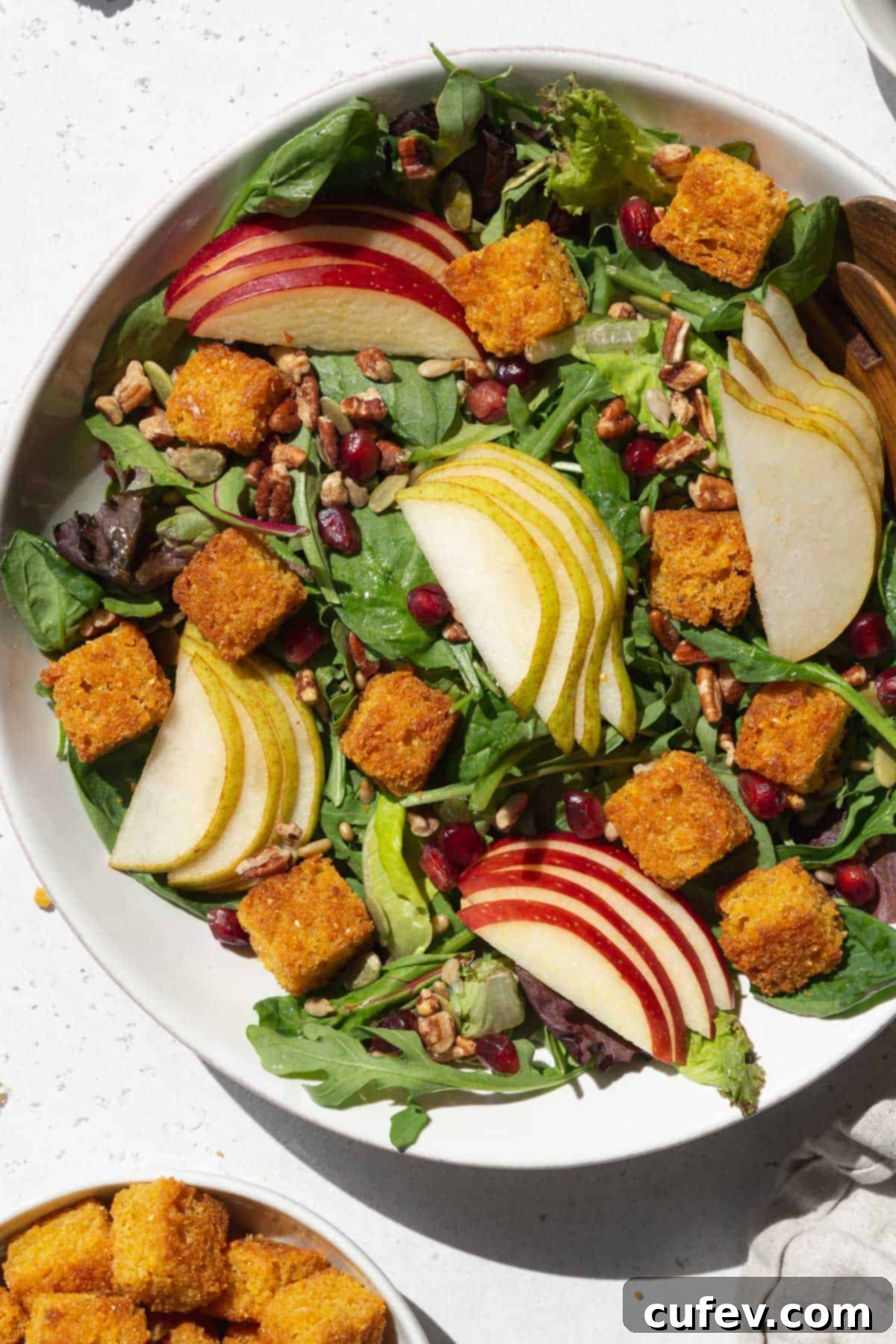
Frequently Asked Questions About Cornbread Croutons
There are a few common culprits when your croutons aren’t as crispy as you’d like. The most frequent reasons include: overcrowding the baking sheet (which traps steam instead of allowing them to crisp), not baking them for a sufficient amount of time, or baking them at too low a temperature. Always ensure a generous 1-inch space between each crouton on the baking sheet to allow for proper air circulation. Additionally, bake them at the specified temperature until they achieve a beautiful golden-brown color and feel firm. Remember, croutons will also continue to crisp up significantly as they cool to room temperature, so be patient! If you’ve followed these guidelines, you should be rewarded with perfectly crunchy croutons.
Unfortunately, homemade croutons will naturally absorb some moisture from the air and soften slightly during storage, making it challenging to keep them *perfectly* crispy long-term without re-crisping. To best preserve their texture, store them in an airtight container at room temperature once they are completely cool. To restore their crispness, simply reheat them in an oven preheated to 350°F (175°C) for 9-11 minutes, or until they are crunchy and warmed through. Avoid refrigerating, as this can make them stale faster.
Cornbread inherently has a more tender and crumbly texture than regular bread, so some slight crumbling is natural. To minimize this, always ensure your cornbread is completely cooled before you attempt to cut it into cubes. Day-old cornbread is even better as it’s firmer. When you’re tossing the cornbread cubes with olive oil and salt, do so very gently. Use a folding motion with a spatula or your hands rather than vigorous stirring, which can cause the delicate bread to break down or fall apart.
The primary reason for tough cornbread is overmixing the batter. When you combine the wet and dry ingredients, stir only until they are just moistened and no streaks of dry flour remain. Resist the urge to continue stirring beyond this point. Overmixing develops the gluten in the flour, leading to a chewy, tough texture rather than the desired light and tender crumb of good cornbread. So, mix gently and just enough!
Absolutely! While simple salt and olive oil are delicious, feel free to experiment with various seasonings to match your meal. Garlic powder, onion powder, smoked paprika, black pepper, a pinch of chili powder for heat, or dried herbs like thyme, oregano, or rosemary all make excellent additions. Mix them in with the salt and olive oil before tossing the cornbread cubes to ensure an even coating.
Discover More Delicious Bread Recipes
- Gluten-Free Cornbread
- Corn Cupcakes with Corn & Blackberry Frosting
- Gluten-Free Banana Bread
- Gluten-Free Pumpkin Bread with Maple Syrup
Thank you so much for joining us and exploring this delightful Cornbread Crouton Recipe! We truly hope you loved making and tasting these savory, crispy bites as much as we do. They truly are a fantastic way to elevate simple meals or transform leftover cornbread into something extraordinary. For even more mouth-watering dairy-free, gluten-free, and/or vegan recipe inspiration, make sure to follow us on Pinterest, Facebook, and Instagram. Don’t want to miss a single delicious update? You can also get all of our newest content delivered straight to your inbox by signing up for our exclusive email newsletter — we promise to only send you the best!
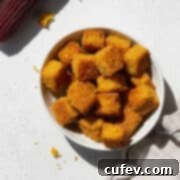
Cornbread Croutons
Print
Pin
Rate
Ingredients
Cornbread
- 1 cup all-purpose flour
- 1¼ cups cornmeal
- ¾ teaspoon fine salt
- ¼ teaspoon baking soda
- 2 teaspoons baking powder
- ½ cup oil
- ¼ cup granulated sugar
- 2 large eggs
- 1 egg yolk
- 1 cup buttermilk
- ¾ cup corn kernels fresh or frozen
Cornbread croutons
- 4 cups cornbread cut into 1 inch (2.5cm) cubes day old works best
- 3 tablespoons olive oil
- ¼ teaspoon fine salt
Instructions
Cornbread
-
Preheat the oven to 400°F (200°C). Grease an 8 x 8-inch square pan with oil and set aside.
-
In a bowl, whisk together the flour, cornmeal, salt, baking soda, and baking powder.
-
Add the buttermilk and corn kernels to a blender and purée until smooth. Pour the mixture into a large mixing bowl with the sugar, oil, eggs, and egg yolk. Stir until combined.
-
Add the cornmeal mixture into the wet ingredients and whisk or stir until smooth.
-
Pour the cornbread mixture into the prepared pan and smooth the top. Bake it for 40-45 min, or until a toothpick inserted in the center comes out clean, with only a few crumbs. Cool the pan of bread completely on a wire rack before cutting.
Cornbread Croutons
-
Preheat the oven to 375°F (190°C).
-
Add the cubed cornbread to a large bowl. Drizzle half of the olive oil and sprinkle half of the salt onto the cornbread and gently toss. Repeat with the remaining oil and salt and gently toss again.
-
Spread the coated cornbread cubes onto a baking sheet in a single layer, keeping about an inch between the cubes.
-
Bake the croutons for 15-20 minutes, tossing once halfway through the baking time. Remove the croutons from the oven and cool on a wire rack. They will get crispier as they cool.
Notes
- Gluten-Free: To make gluten-free cornbread croutons, substitute 1 cup (or 185g) of a 1-to-1 gluten-free flour blend for all-purpose flour. Follow the recipe directions as listed.
- Dairy-Free: Prepare the croutons without dairy by making buttermilk (also known as “sour milk”) with plant milk. To do this, add 1 tablespoon of distilled or apple cider vinegar to a 1-cup measuring cup, then fill the rest of the cup with plant milk. Mix well and allow to sit for 3-5 minutes before incorporating this homemade buttermilk into the recipe.
- Storage: For optimal flavor and texture, enjoy the croutons fresh. If you have leftovers, store them covered in an airtight container at room temperature for 2-3 days. Ensure they are completely cooled before storage.
- Reheat: Croutons will soften slightly when stored. To re-crisp them, spread on a baking sheet and heat in an oven preheated to 350°F (175°C) for 9-11 minutes, or until they become crunchy and heated through.
